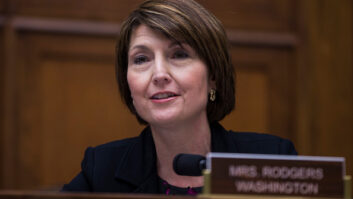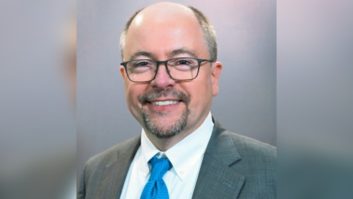One in a series of occasional profiles about radio technology innovators of the past.
The history of our industry has been highlighted by leaders who have glimpsed into the future of broadcasting technology, then taken bold steps to move their companies and the industry ahead. One such figure active in the late 20th century was Larry Cervon, best remembered for his work at Gates Radio and later as president of Broadcast Electronics.
Lawrence John Cervon was born in January 1922 in Lozisca, on the island of Brac off of the coast of Croatia. His family emigrated to the United States in 1928, settling in New York City. Larry graduated from Stuyvesant High School in Manhattan and later he received a bachelor of science degree from the College of the City of New York.
When he enlisted in the U.S. Navy during World War II, his education in electronics began in earnest. After passing a comprehensive aptitude test, Cervon was enrolled in the Navy’s Electronics Training Program or ETP, probably the most comprehensive technical education offered by the armed services. Courses in the 10-month program covered topics from basic electronics to radar. After graduating, Cervon served on board the USS Amphitrite, an Achelous-class repair ship, for the duration of the war. This training and his military service left Cervon well qualified to become a leader in the booming post-war electronics industry.
Big shoes to fill
Following his discharge, Cervon launched his career with brief tenure in New York for RCA International as a broadcast equipment sales trainee. He left after a year to join the broadcast equipment division of Westinghouse Electric, where he worked as a product specialist.
It turned out to be a fortuitous move, for it was there that he met Parker Gates, son of Gates Radio founders Henry C. and Cora B. Gates. That connection led to his employment for the company in 1947 as a sales representative. In 1952, he was promoted to sales manager for Gates Radio. He and his wife Louise made the move to company headquarters in Quincy, Ill.
In 1967, Parker Gates retired and Cervon replaced him as head of the Gates Radio Division of Harris Intertype Corp., which had purchased the company in 1957. At this time, the Gates product line consisted largely of AM and FM transmitters and audio gear. That was about to change.
Cervon set out to expand the company’s offerings into TV products and shortwave transmitters. In a stroke of fortune, General Electric was looking to sell its Syracuse, N.Y.-based broadcast products division at the time. Gates purchased it, and the move saved time and expenses it would have taken to develop a TV product line from scratch. GE’s radio and audio product lines were discontinued.
Once the TV line was established, Cervon set out to differentiate its TV transmitters from those of its biggest competitor, RCA. For that, he hired engineer Hans Bott away from RCA. Bott developed an innovative low-level IF modulation system for TV, Gates patented it, and they began to close the transmitter gap with RCA.
Gates grew to become the second largest manufacturer of TV transmitters. The company received the largest contract in its history for 36 UHF TV and several FM transmitters from the Yugoslav Radio and Television Network.

Building the team
Cervon wanted Gates to become a major player in international broadcasting. Gates had begun to manufacture shortwave transmitters earlier, but it was a small part of the business. The key players in the international transmitter market included RCA, Continental Electronics, Telefunken and ABB/Brown Boveri.
Cervon felt that a complete rethink of AM transmitter technology was in order. That meant finding the right people to lead the project.
According to Geoff Mendenhall, former VP of engineering at Gates/Harris and VP of engineering at Broadcast Electronics, “Larry recruited Hilmer Swanson from Collins Radio. He allocated Swanson ample research funding to develop a more efficient, high-power medium-wave AM transmitter.”
Swanson developed Pulse Duration Modulation or PDM, a system that delivered higher efficiency and better audio fidelity in a smaller size than existing transmitter designs. Gates created a product line of PDM AM transmitters from 5 kW to 100 kW, and PDM shortwave transmitters up to 100 kW. The first PDM transmitter Harris sold was a 100,000 kW medium-wave model for Voice of America, which was delivered to Thailand.
While at Harris, Swanson later developed progressive series modulation (PSM), polyphase PDM and digital amplitude (DX) modulation. He also designed a medium-wave, solid-state transmitter for the Voice of America and several other international customers that delivered 2 million watts; it remains one of the most powerful solid-state AM broadcast transmitters ever built.
High-power radio and TV transmitters have demanding cooling requirements. Under Cervon’s leadership, Gates made improvements in that area as well.
“Larry also hired Arnie Speilbauer, who developed improved liquid-cooling systems, as well as the all-new vapor phase cooling design,” said Mendenhall.
All of these technical advances left a knowledge gap among many engineers at customer sites. To meet that need, Cervon created a training center at Quincy.
“Classroom instruction lasted one to two weeks, and included hands-on experience with equipment undergoing final testing,” Mendenhall said. This later led to a partnership with the local community college to offer an associate’s degree in broadcast engineering technology.
The next chapter
Cervon left Gates in 1974 to become vice president and general manager of the MA Communications Equipment Division of Microwave Associates, but he left MA in 1976 and became president of Broadcast Electronics.

BE was owned at the time by Filmways Inc. and had expanded its product line to include consoles and other audio products, but the bulk of its sales was in cartridge tape machines. It was operating out of cramped facilities in Silver Spring, Md.
As he had done at Gates, Cervon saw opportunities to expand. But in order to grow and augment the product lines, BE also needed to find a new location with larger facilities and access to a workforce skilled in advanced electronics manufacturing.
Under pressure because of the pending expiration of the lease in Silver Spring, Cervon turned back to Quincy, Ill., leasing a commercial building on North 24th Street. In another stroke of luck, Motorola recently had closed a plant in Quincy, leaving many skilled workers unemployed. BE was able to recruit from that pool.
One of Cervon’s first tasks at BE was to expand from audio products into FM transmitters. Early on, he lured Mendenhall away from Harris.
“The commitment to research and development was a big part of the decision,” Mendenhall recalls. “At that time, Harris invested around 10 percent of the operating income in R&D, while BE invested about 12 to 15 percent.” Mendenhall soon became vice president of engineering.
“The innovative, folded half-wave, cavity design for FM transmitters was well under way when I arrived, but BE was also committed to designing its own exciter, rather than private-labeling someone else’s product,” he said. “I expanded on the MS-15 FM exciter that I helped design for Harris to create a new FM exciter for BE called the FX-30. Later, a second-generation exciter, the BE FX-50 was developed at BE.”
BE became part of Orion Pictures, which had purchased Filmways, but in the early 1980s Cervon partnered with venture capital firm Narragansett Capital Corp. to purchase BE and operate it as a privately held company.
With its FM transmitter line well established, creating an AM product line was the next logical step. Cervon had tried to purchase the Collins Radio broadcast transmitter business for its AM assets but lost out to Continental Electronics.
“We ended up building our own line of AM transmitters from 1 kW to 10 kW, using innovative, Class E amplification.” Mendenhall said. BE also introduced a C-Quam AM stereo generator and modulation monitor, later privately labeled for Motorola.
Cervon ended his relationship with BE in 1990.
“When Larry partnered with Narragansett Venture Capital to buy BE from Orion Pictures, he had a good working relationship with them, and BE developed in the way he envisioned it,” Mendenhall said.
“Later, when Narraganset sold the company to Cirrus Corp., they proved more difficult to work with. Larry grew increasingly frustrated because he could no longer run the company the way he wanted, so he sold his interest in BE to Cirrus in 1990 and retired.”
His many years of leadership and service were recognized in 1991 by the National Association of Broadcasters, which honored Cervon with an achievement award “in grateful recognition and appreciation for 45 years of vision and leadership, in the development of high-technology broadcasting equipment.”
Cervon had a passion for international broadcasting, as well as an encyclopedic knowledge of the major players, their facilities and programming. He frequently lectured on this topic in the United States and abroad. He was also a contributor to the book “The History of International Broadcasting,” authored by James Wood.
Cervon passed away in July 2008 at his summer home, in Laurel, N.Y. He suffered from pulmonary fibrosis. He was 86.
The original post of this story misstated the name of the community of Silver Spring, Md., as Silver Springs.






